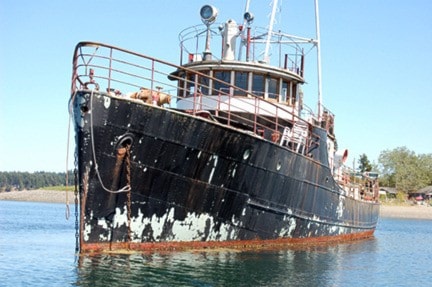Now semi-derelict, the motor vessel Laurier II has worked both sides of the law in her 80-year career.
What appears to be the final curtain is rapidly approaching for two grand dames of the sea, according to recent news reports.
For the Canadian Princess, formerly the hydrographic surveys ship William J. Stewart, and used since 1979 for a floating restaurant at Oak Bay Marine Group’s Ucluelet fishing lodge, it’s definitely a date with the breakers’ yard.
For the former RCMP patrol and fisheries patrol vessel Laurier II, now at anchor in a semi-derelict condition in Deep Bay, the final script has yet to be written. But it doesn’t look promising.
In May it was reported that the Princess, whose lines are those of an ocean-going yacht, was being retired as a fishing lodge and would be scrapped this fall. At that, Oak Bay Marine’s longtime ‘flagship’ has had a lengthy stay of execution; under almost any other circumstances she’d have been cut up long ago. In fact, much of her hydrographic career was a reprieve as she’d once come within a whisker of being totally lost.
That was way back in June 1944 when only 12 years old. Under the command of Capt. J.J. Moore and with a full complement of 65, she struck dreaded Ripple Rock and was badly holed. The inrush of water heeled her hard over in Seymour Narrows’ iron grip but Moore was able to run her ashore in a nearby bay. It took the combined efforts of three powerful tugs to refloat her and tow her to port for repairs.
Upon ultimate retirement as a surveys ship she was purchased for use as the Canadian Princess Lodge. It should go without saying that there’s a story behind her original namesake. Engineer, hydrographic surveyor and civil servant William James Stewart, 1863-1925, was the eldest son of an Irish Anglican family who graduated with honours (including the Governor General of Canada’s Gold Medal) from both the Ottawa Collegiate Institute and the Royal Military College of Canada. After working as a railway survey engineer in Ontario he joined the Dept. of Marine and Fisheries as an assistant to John Boulton, then doing a hydrographic survey of Georgian Bay.
As Canada’s first Chief Hydrographic Surveyor, he came to the West Coast, his re-survey of Burrard Inlet being termed “the first hydrographic survey conducted in salt water by Canadian authorities”. So we’re told by Patrick Burden in the Dictionary of Canadian Biography. Stewart became chief surveyor when the maritime survey functions of Marine and Fisheries, Public Works, and Railways and Canals were combined to form the Canadian Hydrographic Surveys in 1904.
“Impressively,” notes Burden, “Stewart was responsible personally or as a supervisor for producing some 170 charts” (a task far more involved and time-consuming than is apparent at first blush — just look at a navigation chart.) Three years later, working with the International Waterways Commission, he participated in delineating the maritime boundary between Canada and the U.S. And so it went, from one achievement to another including his acting as consultant to the prime minister’s office and the Dept. of External Affairs. The pinnacle of his career, Burden thought, was reached in 1919 “when he was asked to advise the British government on international boundaries arising out of the Treaty of Versailles.”
All of this over a 41-year-long career by a man who effectively had the use of only his left arm. Ever the dedicated civil servant, he was reputed to be demanding of his subordinates, scrupulously vigilant of the public purse and a sound mathematician. He’d even acquired his Inland Waters master’s certificate although he never did command his own survey ship.
As for the William J. Stewart aka the Canadian Princess, Oak Bay Marine Group spokeswoman Susan Barcham said that some of the ship’s more historic interior pieces will be donated to the Ucluelet Historical Society.
Which brings us back to the Laurier II, now at Deep Bay and looking sad. In May the Vancouver Sun reported that the former police craft and fisheries vessel is one of 42 known derelict or abandoned vessels in B.C. waters. So much for her “rich, and until recently, noble history”.
Named for one of Canada’s greatest prime ministers, built in 1936 in Quebec City and launched by Madame Lapointe, wife of the federal minister of justice, she has over the years served as the RCMP patrol and department of fisheries craft Laurier, as HMCS Laurier while serving (armed with a 12-pounder and a .303 machine gun) with the RCN during the Second World War, and as Laurier II by which she’s presently registered. Transferred to the West Coast and retired from all official duties in 1983, she’s had a succession of private owners since 1984.
Ironically, she seems to have been both pursuer and pursued. It’s a matter of record that she was on drug and alcohol patrol in 1936 — it’s strongly rumoured that she “went to the dark side” as a drug runner in the 1990s. Be that as it may, her career appears to be nearing the end. The accompanying photo by John M. MacFarlane (www.nauticapedia.ca) shows her in a state of neglect and he reports that some of her fittings and equipment have been removed.
